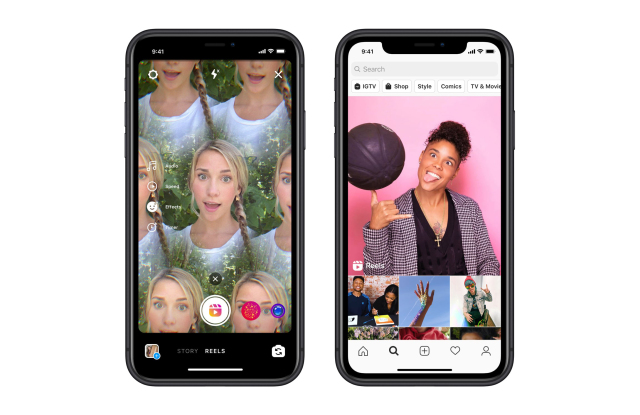As TikTok faces unwanted scrutiny by U.S. officials, Facebook has wasted no time in setting up Instagram to potentially fill the void with Instagram Reels, a new feature for short-form social video content. The update has officially debuted in the U.S., as well as worldwide across 50 countries.
TikTok’s surging popularity among teens and tweens had already queued up a response from Facebook, Instagram’s parent company, even before the latest pressure from the Trump administration. Indeed, the social giant has been testing similar features abroad for years. But as officials now aim to ban TikTok and other China-based tech companies — or compel its owner, Bytedance, to sell off the U.S.-based app — the timing seems ripe for Instagram to speed the new feature into the official launch stage.
The stakes are huge: According to a recent report by social media management platform Sprout Social, the top three industries working with Instagram influencers break down to 91 percent of luxury brands, 84 percent of sportswear brands and 83 percent of beauty brands. While Instagram still dwarfs TikTok, its meteoric rise among young users makes it a threat.
There’s one main thing to know about the new feature and how it differs from the rest of the flagship network: speed. Thumbing through Instagram, which was originally designed for photo-sharing before expanding into videos, isn’t as fast as flipping through TikTok. The latter, which allows users to shoot or crank through a steady diet of short clips quickly, indulges shorter attention spans. So it’s no surprise that it’s become a favorite destination among younger users.
Instagram Reels takes a page from that approach. Users can record and post 15-second clips and, thanks to new editing tools, add augmented reality effects and music. Other features include a countdown timer, captioning and an alignment function, so they can sync up different shots.
Music is no minor point. Across social mediain general — including on Facebook, as well as YouTube and other platforms — crackdowns on video and audio shares have lead to mass revocations of posts for rights issues.
TikTok’s music deals makes a lot of sense in this context, especially since it plays a major part in the app’s attraction with lip-sync challenges, dance moves and other soundtracked clips. Instagram is trying to get in front of that too, having struck agreements with major record labels and other publishers to offer a large library of songs and sounds.
Creators can also use their own audio, which may appeal to artists looking to share their work. “When you share a reel with original audio, your audio will be attributed to you, and if you have a public account, people can create reels with your audio by selecting ‘Use Audio’ from your reel,” the company explained on its blog.
Perhaps most importantly, Reels isn’t a stand-alone app that has to convince potential users that it’s worth the download — unlike rising TikTok competitors Byte, Triller, Zynn and Clash, or Instagram’s own IGTV app.
Reels comes as an update to the Instagram app and sits within the already familiar Instagram camera. The choice resembles Snapchat’s addition of music features to its main app.
What may matter more, once again, is timing: It may work in Facebook’s favor to unleash Instagram Reels while TikTok’s fate is uncertain, but doing it now also means that the company is actively copying a competitor while it is being investigated for anticompetitive behavior.
In no unflinching terms, House Judiciary members questioned Facebook chief executive officer Mark Zuckerberg last week about his company’s habit of copying rivals, such as Snapchat and its Stories feature.
Zuckerberg denied engaging in anti-competitive tactics, though he admitted that Facebook has “adapted features that others have led in.” Now it looks like he’s at it again. What’s less clear is if that will matter to subcommittee members, given TikTok’s roots and the political target on its back.
Either way, for brands and influencers weighing whether to jump on Reels or not, it’s hard to overlook that the feature’s success will probably hinge on what ultimately happens to TikTok — and that’s still a developing situation. The best bet? Stay nimble. And maybe brace for some aftershocks as the social video scene evolves.

